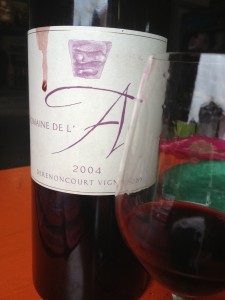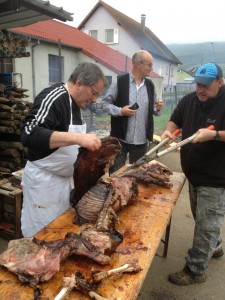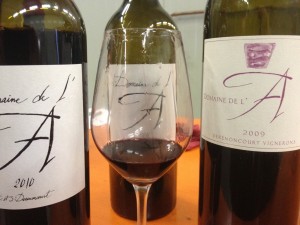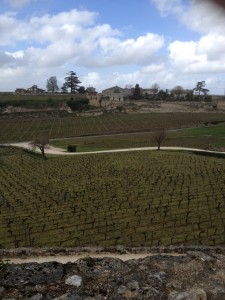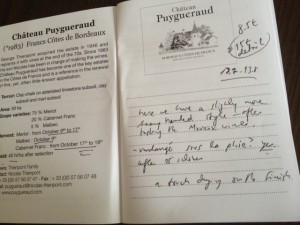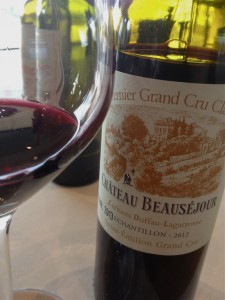Moueix compared to Stéphane Derenoncourt / Nicolas Thienpont
May 1, 2013
A STUDY IN CONTRASTS
Here we have two rather different styles from Right Bank Bordeaux, dominated by the Merlot grape. Compared to Moueix, I get more heat, noticeable extraction and/or dryness from Nicolas Thienpont and Stéphane Derenoncourt, but they are talented in their style of making wine – no doubt about that.
It has been about two weeks since I tasted barrel samples of wines made by the very friendly Nicolas Thienpont, often in cooperation with famous winemaker/consultant Stephane Derenoncourt and David Suire. But I take time now to address the wines, after having tried the 2010 and 2009 vintages of Derenoncourt’s own Domaine de l’A (AOC Cotes de Castillon) in Wettolsheim, Alsace, on 29 April.
Why? Because his wife Christine Derenoncourt flew to Alsace to present her and her husband’s wine along with a fine selection of wines from Domaine Albert Mann for professionals. The Barthelmé family is friends with the Derenoncourt couple.
Now I did enjoy from magnum the 2004 Domaine de l’A. It went very well with a freshly roasted on a spit, just recently hunted down wild boar. The 2004 exuded delicious truffle like tertiary notes, and – by the nature of the vintage – was not coming across as overly concentrated or rich. Just a fine vintage, fresh and delicious. A point, as the French say, for drinking today.
Though I was somewhat duly “impressed” perhaps by the sheer weight of the 2009 and 2010 vintages, I found them also to be a bit heavy handed – and very dark, inky black, in color. OK, backers would say that they are far too young and that in time they will become marvels. Could well be. But I prefer youthful wines with more freshness – and not just massive concentration.
Anyway, after enjoying a lovely day at Domaine Albert Mann – and tasting some great wines from Alsace, notes to be posted later – I was reminded of the notable contrast between the Right Bank barrel samples of Moueix with those tasted on the same on Tuesday 9 April at Château Pavie Macquin. We are talking about two widely respected yet different styles. Click here for COMPLETE NOTES from the Moueix tasting and then read on…
Now, I have been impressed by improvements that Derenoncourt has brought to some estates. His clients in Bordeaux are numerous and include wines I really like, such as Domaine de Chevalier in Leognan and Clos Fourtet in Saint Emilion. Derenoncourt also makes wine in Austria, India, Italy, Lebanon, Spain, Syria, Turkey and the United States and has long become a “rival” or at least as well known as that other famous Bordeaux flying winemaker/consultant Michel Rolland.
So what is his goal for the wines he helps to craft? In a March 2013 interview from decanter.com, Derenoncourt said that his focus is “balance and elegance”. OK, sometimes I get that. For example, I really liked how he worked with Chateau Beausejour Duffau Lagarrosse in 2010.
But other times, I get quite the opposite.
What’s up?
Let’s take a look at 2012 barrel samples (many made with Derenoncourt’s guidance) I had tasted in April 2013 with fellow writer Adam Lechmere, assignment editor for decanter.com, at Chateau Pavie Macquin, with Nicolas Thienpont and David Suire. I think it is safe to say that Nicolas and David follow in the style of Derenoncourt.
Château Puygueraud (Bordeaux Cotes de Francs)
Since 1983, Nicolas Thienpont has been in charge of making the wines here. I have generally liked this wine in the past but this barrel sample served as a noticeable contrast to the barrel samples I had just tasted at Moueix beforehand. I noticed immediately a “heavier” style, a style that is more monolithic that I like less because it exudes less freshness. Well made? Certainly. But not exactly my style. A touch drying on the finish.
Château La Prade (Cotes de Francs)
Acquired by Nicolas Thienpont in 2000. This barrel sample is darker and exudes dark fruits, too. There is greater richness to the mid palate, a plus, but then we get a finish that is marked by oak derivation and somewhat drying tannin.
Château Alcée (Castillon Cotes de Bordeaux)
Thienpont purchased this 3 hectare estate in 2011. There is a more raw and even rough aspect to this sample, and the tannins seem edgier.
Château Trimoulet (Saint Emilion Grand Cru)
Belonging to the same family (Jean) since … 1802, the estate has been under the consultation of both Thienpont and Suire since 2011 and they have, according to the brochure we were given, “revolutionized both viticulture and winemaking methods to reveal all potential of this terroir”. The nose from this sample was certainly rich, and the palate concentrated fruit. Yet, again, there is a noticeable drying aspect on the finish. Where is the freshness???
Château Berliquet (Saint Emilion Grand Cru Classé)
One of the oldest vineyards in Saint Emilion – I recall visiting in 2002, and meeting for the first time a very witty Clive Coates after having seen the limestone tunnels there (one of just a few estates that have them). Owned since 1996 by Patrick de Lesquen, the estate has been under the winemaking guidance of Nicolas Thienpont and Stéphane Derenoncourt since 2008. Certainly this sample is a noticeable step up, marked by more precision and evident flavors on the palate. But still, I feel a lack of freshness, a lack of balancing acidity that one encounters at the Moueix stable.
Château Larcis Ducasse (Saint Emilion Premier Grand Cru Classé B)
This barrel sample represents the first vintage for the estate as promoted to premier status… Owners since 1893, the Gratiot Attmane family in 2002 hired Thienpont and Suire – who benefit from the “advice” of Derenoncourt as written in the brochure – to “combine traditional methods and innovative techniques to enhance the flavors of this earth”. I recall Larcis Ducasse being a “charming wine” for example in 1997. But it was never a Parker Darling. So here, I see that the wine has improved in some ways, less of a wall flower – for example. And this barrel sample shows, at last, a bit of freshness, compared to the previous samples. As previously noted the day before, in a blind tasting, the attack is rather supple, with fine intensity of flavor on the palate, plum like fruit, a longish finish. OK, the tannins are a tad aggressive on the mid palate (this could just be due to the vintage), but they are also “contained” – in that they do not exactly assault your gums. I can sense the 65% new oak, particularly on the aromas, and a slight sense of being “made up” – again, in comparison to the fresher style one obtains chez Moueix. But this is not bad at all in the context of the vintage. Good job!
Château Pavie Macquin (Saint Emilion Premier Grand Cru Classé B)
Since 1994, Nicolas Thienpoint manages this estate and relies on the counsel of Stéphane Derenoncourt to, as the brochure notes, “tame the natural power of the terroir and achieve elegance and find the power of elegance.” Well, I found more power … than elegance! Certainly the nose – as tasted the day before in a blind assessment – exuded intriguing clove and spice, some of which came from oak derivation. The palate again came across with medium flavor intensity, but exuded a somewhat drying quality, and did not give off the necessary freshness to be truly described as “elegant”. Anyone who would compare, say, Chateau Canon with this wine, could sense the difference. Canon is truly elegant. Pavie Macquin has more power and conveys its extraction.
Château Beausejour Duffau Lagarrosse (Saint Emilion Premier Grand Cru Classé B)
Property of the Duffau Lagarrosse heirs since the mid 19th century, this Premier Grand Cru Classé enjoys a superb terroir. Since 2009, the winemaking has been managed by Nicolas Thienpont and David Suire. I liked the 2010 from barrel, although the oak derivation was somewhat noticeable – and the sample was not as fresh as, say, Figeac or Canon. I have not yet tasted the 2010 from bottle, but will try to do so in a vertical during Vinexpo. In any case this 2012 is (perhaps not surprisingly) the best barrel sample of them all tasted at Pavie Macquin. OK, the color is black ink… but the nose is very endearing, very aromatic, and the attack is supple building to a sap filled mid palate (nicely done!), but… Yes, there is a but. It does dry out just a bit, yet again. I can feel the extraction, whereas a wine like La Fleur Petrus, Latour a Pomerol or Trotanoy… you do not feel any extraction, you get a sense of seamlessness. So, in the context of style, you will get more oomph and power no doubt from BSDL, but the greater elegance, the freshness, you will find elsewhere!
Many thanks to Nicolas Thienpont and to David Suire for hosting the tasting. I appreciate the hard work that they put into their wines, and applaud them. But they would understand that there are subjective tastes to wines… I want to revisit their wines each year and continue to assess their progress, especially in bottle.
See my notes for barrel samples from the other Bordeaux appellations in 2012:
Graves and Pessac Leognan / Sauternes and Barsac / Margaux-Moulis-Listrac / Pauillac / Saint Julien / Saint Estephe / Saint Emilion / Pomerol / Haut Medoc

